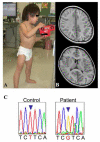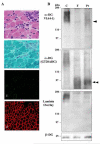A novel POMT2 mutation causes mild congenital muscular dystrophy with normal brain MRI
- PMID: 18804929
- PMCID: PMC2702532
- DOI: 10.1016/j.braindev.2008.08.005
A novel POMT2 mutation causes mild congenital muscular dystrophy with normal brain MRI
Abstract
We report a patient harboring a novel homozygous mutation of c.604T>G (p.F202V) in POMT2. He showed delayed psychomotor development but acquired the ability to walk at the age of 3 years and 10 months. His brain MRI was normal. No ocular abnormalities were seen. Biopsied skeletal muscle revealed markedly decreased but still detectable glycosylated forms of alpha-dystroglycan (alpha-DG). Our results indicate that mutations in POMT2 can cause a wide spectrum of clinical phenotypes as observed in other genes associated with alpha-dystroglycanopathy. Presence of small amounts of partly glycosylated alpha-DG may have a role in reducing the clinical symptoms of alpha-dystroglycanopathy.
Figures


Similar articles
-
A fourth case of POMT2-related limb girdle muscle dystrophy with mild reduction of α-dystroglycan glycosylation.Eur J Paediatr Neurol. 2014 May;18(3):404-8. doi: 10.1016/j.ejpn.2013.10.005. Epub 2013 Oct 27. Eur J Paediatr Neurol. 2014. PMID: 24183756
-
Congenital muscular dystrophy with muscle inflammation alpha dystroglycan glycosylation defect and no mutation in FKRP gene.J Neurol Sci. 2006 Apr 15;243(1-2):47-51. doi: 10.1016/j.jns.2005.11.024. Epub 2006 Jan 4. J Neurol Sci. 2006. PMID: 16386759
-
Refining genotype phenotype correlations in muscular dystrophies with defective glycosylation of dystroglycan.Brain. 2007 Oct;130(Pt 10):2725-35. doi: 10.1093/brain/awm212. Epub 2007 Sep 18. Brain. 2007. PMID: 17878207
-
[Fukuyama congenital muscular dystrophy and related alpha-dystroglycanopathies].Brain Nerve. 2008 Oct;60(10):1159-64. Brain Nerve. 2008. PMID: 18975603 Review. Japanese.
-
Telethonin-deficiency initially presenting as a congenital muscular dystrophy.Neuromuscul Disord. 2011 Jun;21(6):433-8. doi: 10.1016/j.nmd.2011.03.005. Epub 2011 May 6. Neuromuscul Disord. 2011. PMID: 21530252 Review.
Cited by
-
A homozygous mutation in the POMT2 gene in four siblings with limb-girdle muscular dystrophy 2N.Turk Arch Pediatr. 2021 Jan 1;56(1):68-71. doi: 10.14744/TurkPediatriArs.2020.37880. eCollection 2021 Jan. Turk Arch Pediatr. 2021. PMID: 34013233 Free PMC article.
-
Biochemical correlation of activity of the α-dystroglycan-modifying glycosyltransferase POMGnT1 with mutations in muscle-eye-brain disease.Biochem J. 2011 Jun 1;436(2):447-55. doi: 10.1042/BJ20101059. Biochem J. 2011. PMID: 21361872 Free PMC article.
-
Phenotype and Genotype Study of Chinese POMT2-Related α-Dystroglycanopathy.Front Genet. 2021 Aug 3;12:692479. doi: 10.3389/fgene.2021.692479. eCollection 2021. Front Genet. 2021. PMID: 34413876 Free PMC article.
-
Structure of the eukaryotic protein O-mannosyltransferase Pmt1-Pmt2 complex.Nat Struct Mol Biol. 2019 Aug;26(8):704-711. doi: 10.1038/s41594-019-0262-6. Epub 2019 Jul 8. Nat Struct Mol Biol. 2019. PMID: 31285605 Free PMC article.
-
Uniparental disomy unveils a novel recessive mutation in POMT2.Neuromuscul Disord. 2018 Jul;28(7):592-596. doi: 10.1016/j.nmd.2018.04.003. Epub 2018 Apr 10. Neuromuscul Disord. 2018. PMID: 29759639 Free PMC article.
References
-
- Kim DS, Hayashi YK, Matsumoto H, Ogawa M, Noguchi S, Murakami N, et al. POMT1 mutation results in defective glycosylation and loss of laminin-binding activity in alpha-DG. Neurology. 2004;62:1009–11. - PubMed
-
- Akasaka-Manya K, Manya H, Nakajima A, Kawakita M, Endo T. Physical and functional association of human protein O-mannosyltransferases 1 and 2. J Biol Chem. 2006;281:19339–45. - PubMed
-
- Mercuri E, D’Amico A, Tessa A, Berardinelli A, Pane M, Messina S, et al. POMT2 mutation in a patient with ’MEB-like’ phenotype. Neuromuscul Disord. 2006;16:446–8. - PubMed
-
- Yanagisawa A, Bouchet C, Van den Bergh PY, Cuisset JM, Viollet L, Leturcq F, et al. New POMT2 mutations causing congenital muscular dystrophy: identification of a founder mutation. Neurology. 2007;69:1254–60. - PubMed
Publication types
MeSH terms
Substances
Grants and funding
LinkOut - more resources
Full Text Sources
Other Literature Sources
Medical

